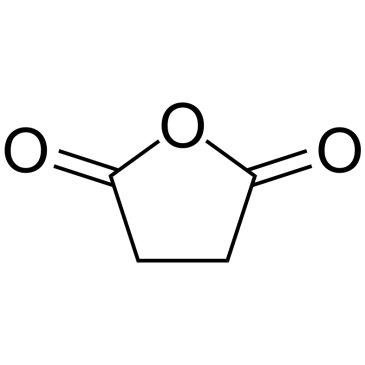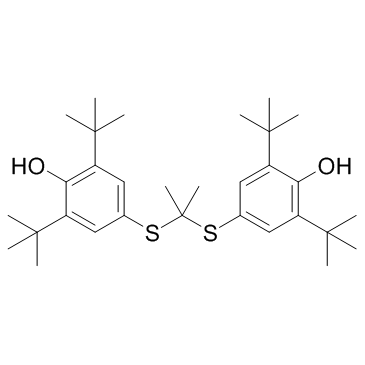216167-82-7
| Name | 4-[2,6-ditert-butyl-4-[2-(3,5-ditert-butyl-4-hydroxyphenyl)sulfanylpropan-2-ylsulfanyl]phenoxy]-4-oxobutanoic acid |
|---|---|
| Synonyms |
AGI-1067
Succinobucol (USAN) UNII-J1J54V24R4 4-[2,6-di-tert-butyl-4-({2-[(3,5-di-tert-butyl-4-hydroxyphenyl)sulfanyl]propan-2-yl}sulfanyl)phenoxy]-4-oxobutanoic acid mono-succinylprobucol probucol monosuccinyl ester [mono[4-[[1-[[3,5-bis(1,1-dimethylethyl)-4-hydroxyphenyl]thio]-1-methylethyl]thio]-2,6-bis(1,1-dimethylethyl)phenyl]ester] (butanedioic acid) probucol monosuccinate Succinobucol mono [4-[[1-[[3,5-bis(1,1-dimethylethyl)-4-hydroxyphenyl]thio]-1-methylethyl]thio]-2,6-bis(1,1-dimethylethyl)phenyl] ester |
| Description | Succinobucol is a phenolic antioxidant with anti-inflammatory and antiplatelet effects. |
|---|---|
| Related Catalog | |
| In Vitro | Succinobucol (10, 50, 100 μM) causes a dose-dependent reduction in collagen-induced platelet aggregation in rabbit whole blood. Succinobucol also causes a significant reduction in whole blood aggregation in response to ADP. Succinobucol (10, 100 μM) significantly lowers the relaxation to X/XO[1]. Succinobucol significantly prevents 3-NP-induced loss of SH-SY5Y cell viability, generation of reactive oxygen species, and decrease of ΔΨm. Succinobucol does not protect against 3-NP-induced inhibition of mitochondrial complex II activity, pointing to the mitigation of secondary events resultant from mitochondrial complex II inhibition. Succinobucol significantly increases (50 %) the levels of GSH in SH-SY5Y cells, which is paralleled by significant increases in glutamate cysteine ligase messenger RNA (mRNA) expression and activity[2]. Succinobucol effectively exhibits superior inhibitory effects on cell migration and invasion activities, VCAM-1 expression and cell-cell binding of RAW 264.7 to 4T1 cells. Succinobucol also shows inhibitory effect on VCAM-1 expression in 4T1 cells and cell-cell binding of RAW 264.7 to 4T1 cancer cells[3]. |
| In Vivo | Succinobucol (50, 100, and 150 mg/kg, i.v.) has no significant effect on either heart rate or MAP, but the blood removed 15 minutes after the final injection of succinobucol shows significantly less aggregation in response to collagen at both 5 µg/mL and 20 µg/mL in rats[1]. Succinobucol (40 mg/kg) by tail injection significantly reduces the average number of metastatic nodules in lung metastatic breast cancer mice[3]. |
| Cell Assay | The cytotoxicity of Succinobucol is determined in the metastatic 4T1 breast cancer cells. Cells are added to 96-well plates at 6×103 cells/well and cultured overnight. Then, Succinobucol, SCB and the PCD polymer (equivalent concentration to SCB) are respectively added to each well with SCB concentrations ranging from 4 ng/mL to 40 μg/mL. Cells without any treatment are performed as negative control. Thereafter, cells are incubated for further 48 h, and the cell viability is measured by MTT assay method. |
| Animal Admin | Mice are injected with 2×105 4T1-luc cells per mouse to generate the lung metastatic breast cancer model. After the inoculation, mice are divided into three groups (n=4), and respectively treated with saline, SCB solution and Succinobucol (40 mg/kg) by tail injection every three days. At day 12, the formation of lung metastasis is determined by in vivo bioluminescence measurements. Then, mice are autopsied and the lung tissues are removed. In each lung tissue, the visually detected metastatic nodules are counted. The inhibition of lung metastasis is calculated as the average metastatic nodules in Succinobucol or SCB group compared to that in saline group. Moreover, the histological examination is performed by H&E staining to detect the metastatic foci in the lungs. |
| References |
| Density | 1.13g/cm3 |
|---|---|
| Boiling Point | 659.5ºC at 760mmHg |
| Molecular Formula | C35H52O5S2 |
| Molecular Weight | 616.91400 |
| Flash Point | 352.7ºC |
| Exact Mass | 616.32600 |
| PSA | 134.43000 |
| LogP | 9.97290 |
| Appearance | white solid |
| Vapour Pressure | 2.71E-18mmHg at 25°C |
| Index of Refraction | 1.571 |
| Storage condition | -20℃ |
|
~44% 
216167-82-7 |
| Literature: US2005/267187 A1, ; Page/Page column 17 ; |
|
~11% 
216167-82-7 |
| Literature: Luo, Xin-Feng; He, Ling; Yin, Hai-Bin; Zheng, Hu; Bei, Di; Deng, Jin-Jin; Huang, Wen-Cai Synthetic Communications, 2009 , vol. 39, # 19 p. 3444 - 3452 |
| Precursor 2 | |
|---|---|
| DownStream 0 | |


